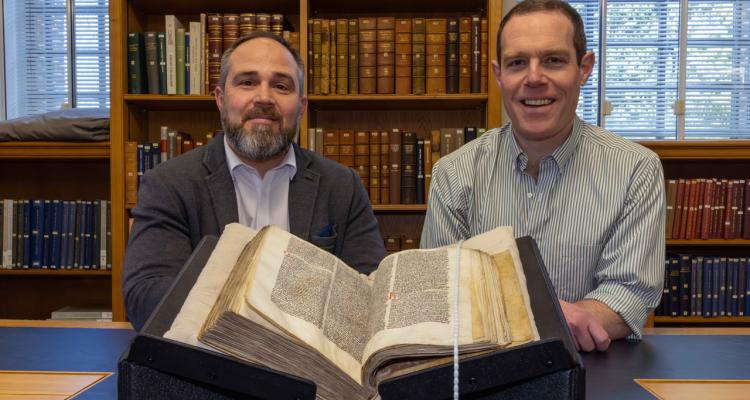Photo credit: University of Cambridge
Girton Fellows Dr James Wade and Dr Seb Falk have solved a medieval literary mystery that has perplexed scholars for 130 years, providing the key to deciphering the most famous puzzle in Chaucer’s writings.
The Song of Wade is a long-lost gem of English literature. Discovered in Cambridge in 1896 by M.R. James, the only surviving fragment of this once widely known tale exists as a reference in the 800-year-old Humiliamini sermon, found in MS 255, a collection of medieval sermons held by Peterhouse College.
Until now, the tale was believed to be a mythical, monster-filled epic, but in a study published today in The Review of English Studies, Dr Wade and Dr Falk reanalyse the fragment found in MS 255 and show that the tale was really one of chivalric romance – a perspective that makes sense of Chaucer’s references to the mythical knight Wade in terms of courtly intrigue.
Through situating the fragment of the tale in the wider context of the Humiliamini sermon, the pair’s analysis homed in on the historic misreading by scholars of just three words. This error has an outsized impact when examining such a small fragment of a missing text and, Dr Wade and Dr Falk argue, seems to have been induced by the misleading hand of the sermon’s original transcriber, who appears to have had particular difficulty forming ‘y’ and ‘w’. This led scholars to confuse these letters, producing the following mythologically tinged translation:
‘Some are elves and some are adders; some are sprites that dwell by waters: there is no man, but Hildebrand only.’
However, adjusting for the scribe’s problematic hand and other errors, a more realistic tone appears, one befitting the genre of chivalric and courtly romance:
‘Some are wolves and some are adders; some are sea-snakes that dwell by the water. There is no man at all but Hildebrand.’
This discovery not only clarifies Chaucer’s references to the mythical knight Wade in his ‘Merchant’s Tale’ and his epic poem, Troilus and Criseyde, but also illuminates the world of medieval sermonising, providing rare and exciting evidence of a preacher engaging audiences through pop cultural reference.
Watch the video below to learn more from Dr Wade and Dr Falk about their discovery, its impact, and the world of medieval sermonising.

